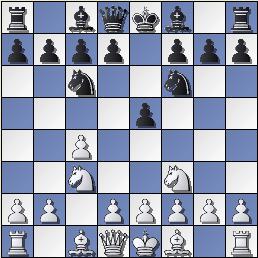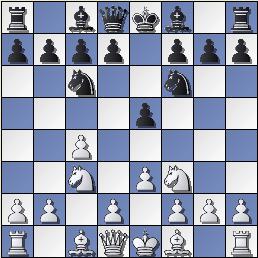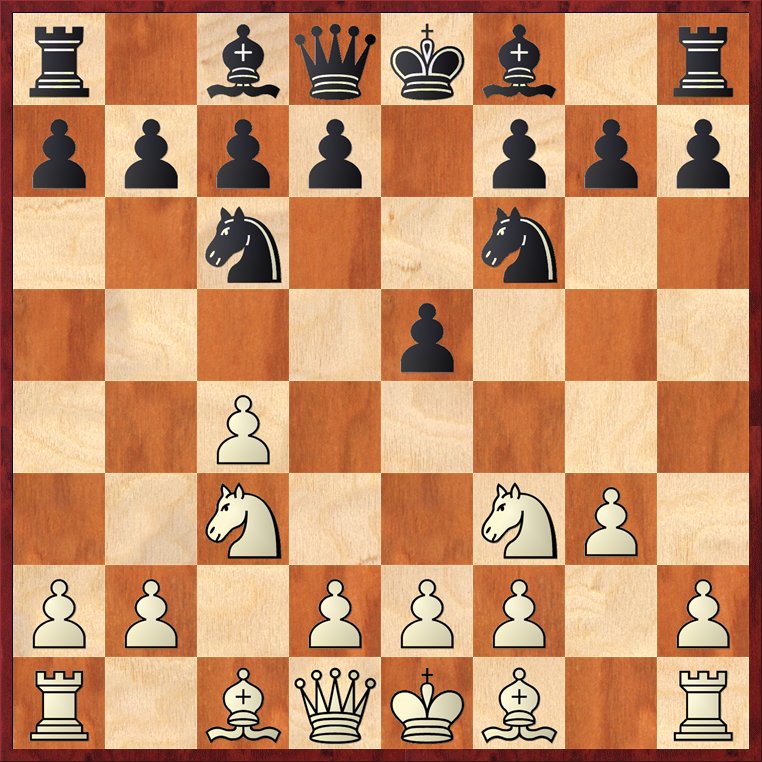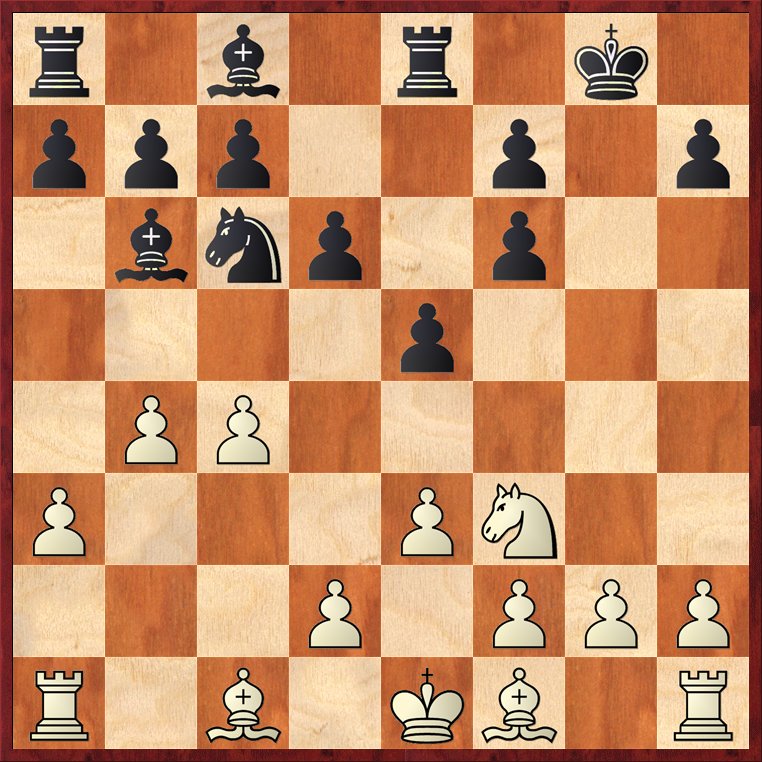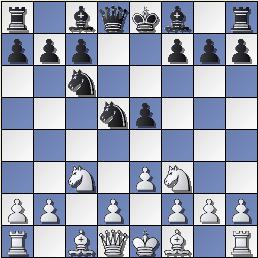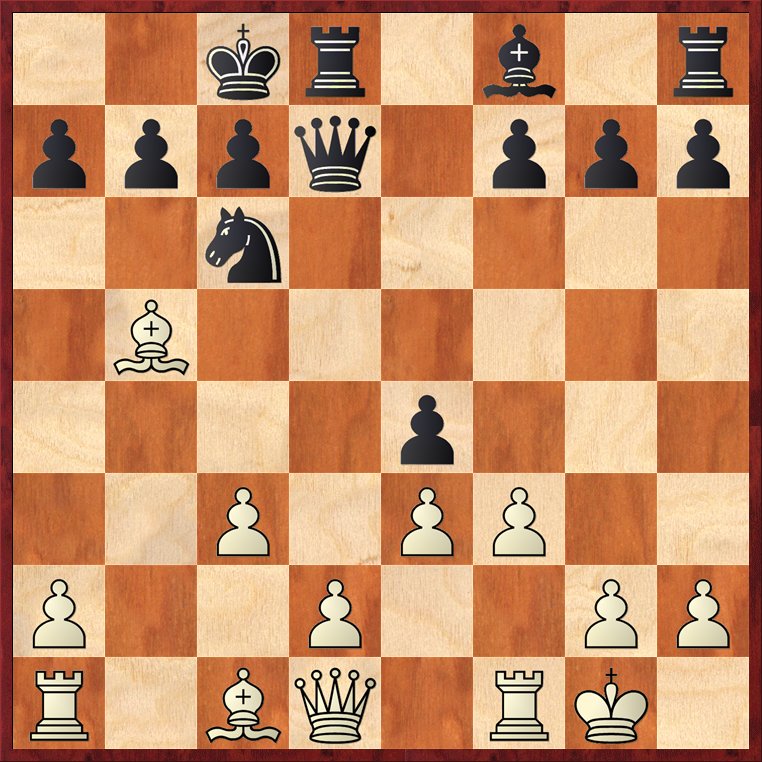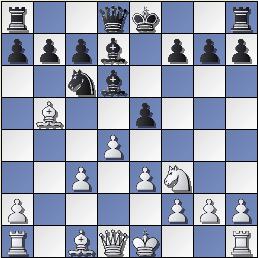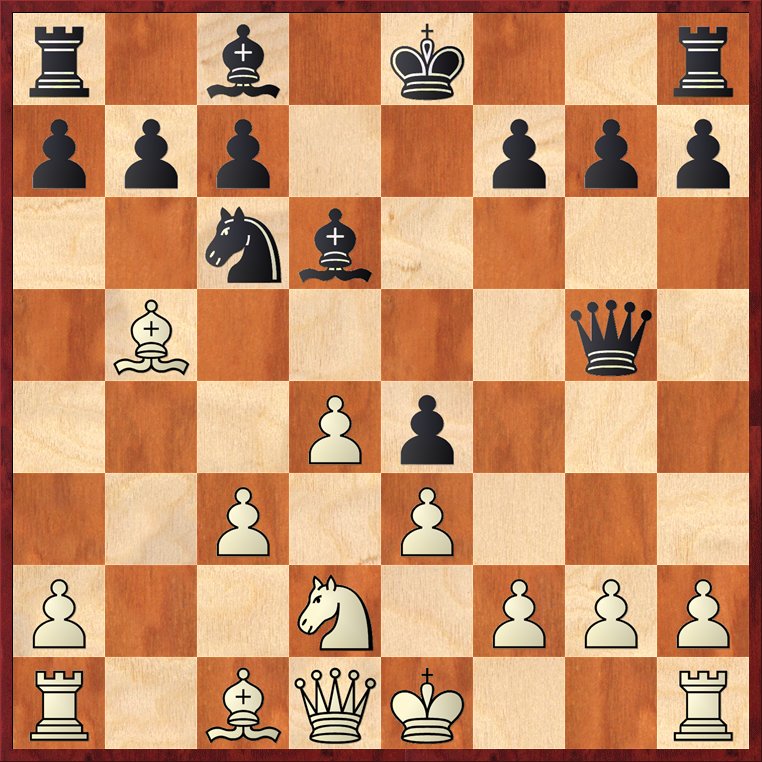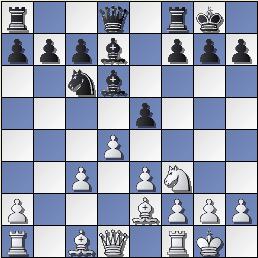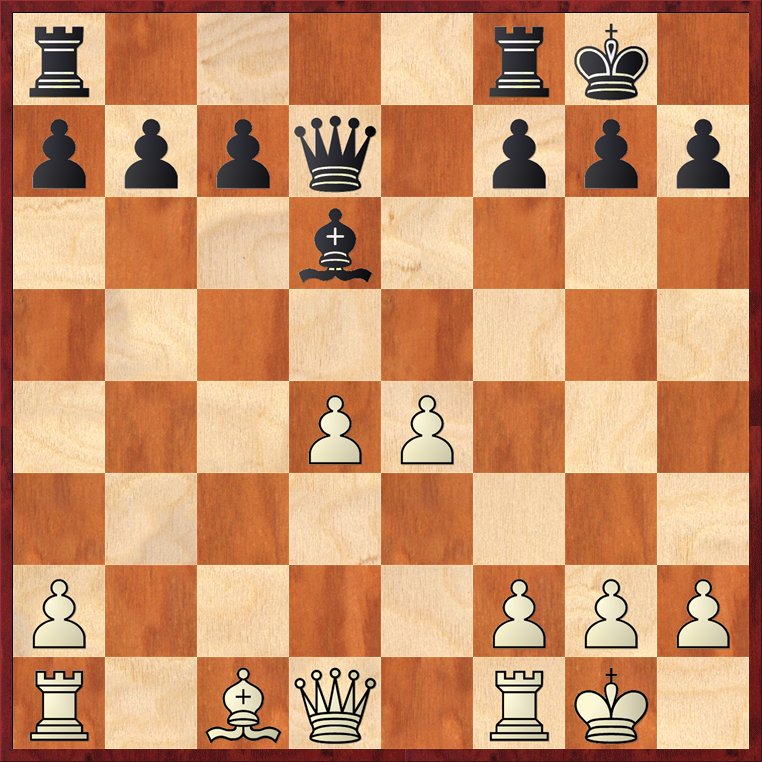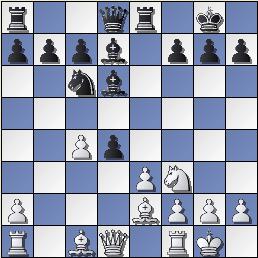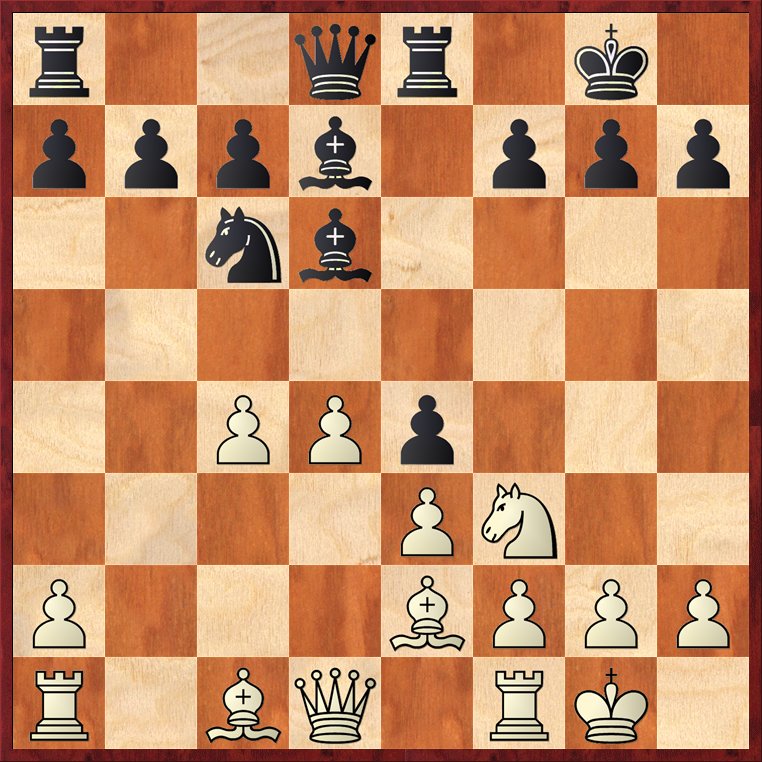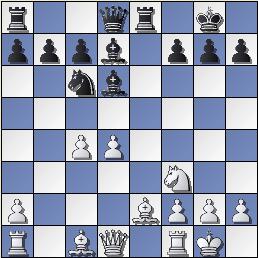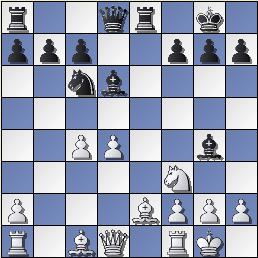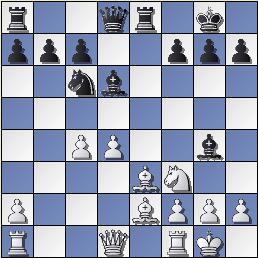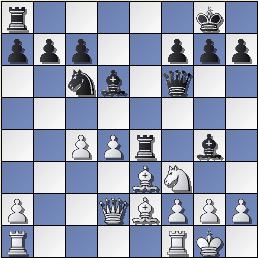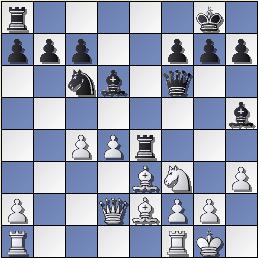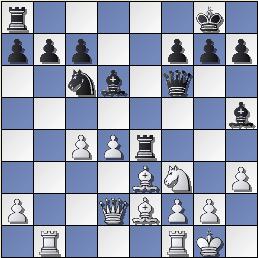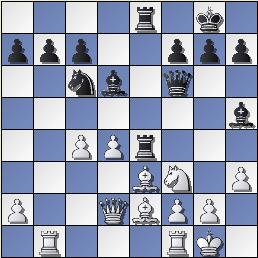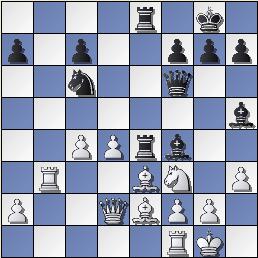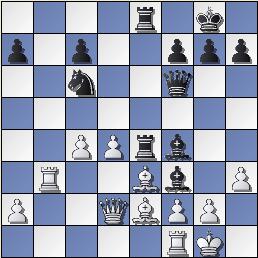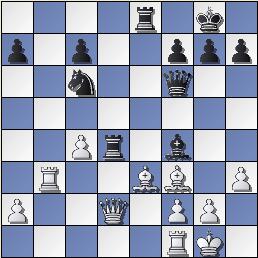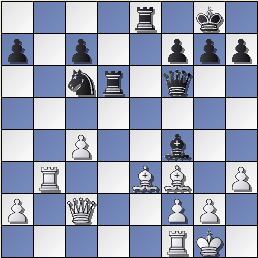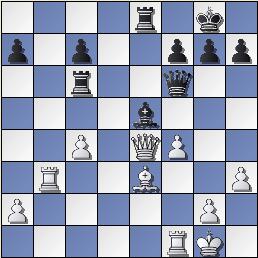All
the |
(Navigation bar
directly below.)
*******
© A.J. Goldsby, 2015.
(All rights reserved.)
****************
Click HERE
to see my
Chess Items.
****************
****************
Buy a book
from Amazon.com
(And help me out as well!)
****************
Click HERE
...
to see a list of the businesses that help to sponsor all of
my chess efforts.
CG
- "Problem of the Day"
(FRIDAY / February 17th,
2012.)
Click HERE to see an explanation of the symbols that I commonly use when I annotate any chess game.
Click HERE to replay this game ... on another server.
Click HERE to go to my channel on the "You-Tube" server. (Click HERE to see the video on this particular game.)
NOTE: I always wanted to do at least one web page for this player ...
-
- I started on this page back in February. However, I had many interruptions, I did not take it up again until late May.
GM Leonid Shamkovich
(2547) - IM G. Lebredo
(2456)
|
|
|
[A.J. Goldsby I]
POTD / Friday; February 17th, 2012.
*************************************************************************************************************************************************************
The ratings are not those of FIDE, but were taken from the website of the chess statistician, Jeff Sonas.
An interesting game ...
I personally met GM
L. Shamkovich
(many years ago); I may even have his autograph in one of my chess books somewhere ...
I clearly remember when he first defected from the (old) U.S.S.R. (Russia) and came to
the U.S., he seemed to win most of the tournaments that he played in.
I thought that I would annotate
this game as my personal tribute to a very strong chess master.
(According to the "Chess Metrics" website,
GM Leonid A. Shamkovich was rated #19 in the world
in 1966!)
1.c4 e5; 2.Nc3 Nc6; 3.Nf3 Nf6;
|
|
r1bqkb1r/pppp1ppp/2n2n2/4p3/2P5/2N2N2/PP1PPPPP/R1BQKB1R w KQkq - 0 4
The Four Knights (after 1...e5;) one of the most common positions of the English in the database.
4.e3,
Interesting. (This is not a main line, I would have to say that Shamkovich might have played
this to throw his opponent on his own resources. Of course, this is just a guess. If he were
alive today, I might send him an e-mail and ask him ...
but - of course! - this is not possible ... as he passed away in 2005.)
|
|
r1bqkb1r/pppp1ppp/2n2n2/4p3/2P5/2N1PN2/PP1P1PPP/R1BQKB1R b KQkq - 0 4
However, 4.e3, is a good, move that controls the key d4-square, and prepares (possibly) Be2, followed by castling on the King-side.
[ By far, the most traveled route (the main line) would be: 4.g3, see ECO or MCO-15 for more details here.
|
|
r1bqkb1r/pppp1ppp/2n2n2/4p3/2P5/2N2NP1/PP1PPP1P/R1BQKB1R b KQkq - 0 4
See also MCO-15, the coverage of the English begins on page # 675.
[For the lines that I am specifically referring to here, see MCO-15, page # 680, beginning with col. #01.] ]
4...d5;
Black breaks in the center ... and there is certainly nothing wrong with that.
[MCO and
the "Power-Book" give (instead) 4...Bb4 here.]
[ One popular reference work gives
the following continuation ...
(I also found this line in the
Fritz "Power-Book" and several books on the English.):
4...Bb4; 5.Qc2 0-0; 6.Nd5 Re8; 7.Qf5!? d6; 8.Nxf6+ Qxf6; 9.Qxf6 gxf6; 10.a3 Bc5; 11.b4 Bb6; "="
The end of the column.
|
|
r1b1r1k1/ppp2p1p/1bnp1p2/4p3/1PP5/P3PN2/3P1PPP/R1B1KB1R w KQ - 0 12
This position is very close to being equal, however, White has some practical chances
because of
Black's set of doubled Pawns.
[See MCO-15, page # 682; col. # 09, and all notes.]
This position is not without chances for White, I found that many players have gotten
the full point from here.
(Karpov, Korchnoi, Agdestein,
and many others.)
I looked at 25-30 of these, probably the game that I like the best would be:
GM Anthony J. Miles (2550) - GM A.
Rodriguez-Cespedes (2555);
[A28] /
ICT, Masters / Yopal, COL; (Round #05) / 1997.
{White won a very sharp
game,
1-0 in only 25 crisp moves.} ]
5.cxd5 Nxd5; <only move>
A curious position, its like a
<reversed> Open Sicilian ... but with colors reversed.
(In fact, White could play 6.e4, here and play a Sveshnikov Sicilian, but again,
the colors would be opposite of what is considered to be 'normal' for the opening.)
|
|
r1bqkb1r/ppp2ppp/2n5/3np3/8/2N1PN2/PP1P1PPP/R1BQKB1R w KQkq - 0 6
Note the Pawn structure.
(Here is where knowledge of many opening systems comes in handy. Let's say you have never played
or studied any of the systems of the Sicilian Defense. If so, you might not understand how to
properly play and conduct the first player's orchestra.)
*******************************************************************************************************************************************************
(White's next move is logical, as it pins a Knight, threatens to wreck Black's pawn structure with Bxc6, and also prepares a quick castling. The first player could also have played 6.d3, and played a position that would be a type of a Scheveningen Sicilian ... but with colors reversed.)
6.Bb5 Nxc3; 7.bxc3 Bd6;
Smooth, consistent and logical development, although many of the engines choose 7...e4!?
[ A sharp alternative ... that may have been overly risky
for Black ... would have been:
RR 7...e4!?; 8.Ne5 Bd7;
9.Nxd7 Qxd7; 10.0-0 0-0-0; 11.f3, " +/= "
|
|
2kr1b1r/pppq1ppp/2n5/1B6/4p3/2P1PP2/P2P2PP/R1BQ1RK1 b - - 0 11
White has a solid edge.
(When you castle on
opposite sides, its usually a race to see who can get to the other guy's
King
first. White has the upper hand because of the Bishop pair, more Pawns in the center,
and the first player
already has a half-open b-file to the Black King.)
I found no games in the db that arose from this position. ]
8.d4 Bd7; (Too passive?)
Black 'develops' a piece, yet it seems to be more "in the way" (blocking) Black's other pieces,
than occupying a really useful post.
|
|
r2qk2r/pppb1ppp/2nb4/1B2p3/3P4/2P1PN2/P4PPP/R1BQK2R w KQkq - 0 9
Everyone - at one time or the other - has lost a game due to having <weak> doubled pawns. In this light, we can understand why Black wanted to avoid having his basic (P) skeleton damaged. [Black's last move defends c6 and (also) prevents Black from getting doubled and isolated c-pawns.]
[ A very lively alternate continuation for Black was
the idea found by the machine here:
(>/=)
8...e4; ('!') 9.Nd2 Qg5;
"~" (unclear)
|
|
r1b1k2r/ppp2ppp/2nb4/1B4q1/3Pp3/2P1P3/P2N1PPP/R1BQK2R w KQkq - 0 10
when if White plays the indicated move, according to the chess engines, (i.e., 10.Bf1);
Black has the chance to turn the
tables on White ... and try to gain the upper hand. ]
Now both sides castle and get their Kings to a safer position. (Away from the center.)
9.0-0 0-0; 10.Be2,
A curious decision, White withdraws his Bishop, (losing time); possibly this was
due to some tactical threats, as the lurker on b5 is not guarded.
|
|
r2q1rk1/pppb1ppp/2nb4/4p3/3P4/2P1PN2/P3BPPP/R1BQ1RK1 b - - 0 10
I thought that the indicated move was 10.e4, but this leads to a lot of simplification, (and possibly a draw with a lower-rated player - see the analysis just below); which may be the reason that Shamkovich avoided 10.e3-e4.
[ Both Fritz 12 and Houdini 1.5
authenticate the following line:
10.e4
Nxd4!; 11.Nxd4T, (Forced.)
The engines confirm that this
move was the only correct continuation for White.
( Inferior was the line: </= 11.cxd4? Bxb5; "/+"
(Black has a large advantage.)
and Black is clearly better. (After 12.Re1, exd4; the first player is down a Pawn.)
)
11...exd4; 12.Bxd7 Qxd7; 13.cxd4, "=" (Maybe "+/=")
|
|
r4rk1/pppq1ppp/3b4/8/3PP3/8/P4PPP/R1BQ1RK1 b - - 0 13
when White's small edge in space and two Pawns in the center are offset by Black's
lead in development
and more active piece play.
(This simplified - probably drawish - continuation may be the reason that White
withdrew his LSB.)
Editor's Note: This
is only an intelligent guess, of course I cannot prove this, there may have
been other
reasons
as to why Shamkovich played this move. And - as I have already noted - he is
no longer in the land
of
the living, so perhaps we will never know his exact reasons or the logic why
White played this particular
position
... in the way that he did. ]
Black's next move places his Rook behind his KP; if the file is opened, this key "heavy piece" will be on a more effective post than on f8.
10...Re8; 11.c4 exd4!?;
A key decision, which changes the Pawn structure.
|
|
r2qr1k1/pppb1ppp/2nb4/8/2Pp4/4PN2/P3BPPP/R1BQ1RK1 w - - 0 12
I
wonder if GM Shamkovich went for this position knowing that a less experienced player
would make this exchange.
(Or had he seen some of his opponent's games and thus he had glimpsed an insight
into his opponent's style of play?)
[ Probably a superior continuation would have been: >/= 11...e4, "=/+" (A slight edge for Black.)
|
|
r2qr1k1/pppb1ppp/2nb4/8/2PPp3/4PN2/P3BPPP/R1BQ1RK1 w - - 0 12
when Black is probably going to gain the upper hand. (This fact was confirmed by Fritz, Houdini, and Deep Junior.) ]
12.exd4; ("Pawn Pair" -- White
Pawns on d4 & c4.)
Now White has the type of Pawn structure known as "The hanging Pawns, " which
is a duo of Pawns, side-by-side on the fourth rank, with no
possible (protecting) Pawns to either the right or the left; see the position just below.
|
|
r2qr1k1/pppb1ppp/2nb4/8/2PP4/5N2/P3BPPP/R1BQ1RK1 b - - 0 12
White has a slight edge in space, the more skilled player will use this as an opportunity to confuse his (or her) opponent, possibly creating dynamic threats to advance either Pawn at the correct time. (The second player will remain constantly concerned about this very real threat.) However, with Black's pieces bunched in the middle of the board, (three pieces on the half-open d-file!); the second player does not have the kind of piece set-up that would allow him (or her) to gain the upper hand from this particular position.
A normal - and very good plan
for Black - would be to focus all of his firepower on c4, and force White to advance the
button to avoid losing it.
[This would leave White with a backward Pawn on the half-open d-file and leave
Black with a clear advantage.]
However, here - as I have already noted - Black does not have the proper piece
configuration to realistically pull off such a scheme.
[ Instead, after these moves ... say that White was intentionally playing to try and avoid
the pawn pair in the center of the chess board here ... and instead played the following
continuation: </=
12.Nxd4?! Nxd4; 13.Qxd4?? Be5;
"-/+" (In this position - Black is
winning.)
(and)
White will lose a Rook on a1.
]
Now Fritz is showing that Black should play ...b7-b6; here ... while Houdini is giving the nod to the active play of ...Bf5.
12...Bg4!?; (light squares)
This "semi-pin" is not a bad move here, yet it does not seem to be the proposal ...
|
|
r2qr1k1/ppp2ppp/2nb4/8/2PP2b1/5N2/P3BPPP/R1BQ1RK1 w - - 0 13
(...) "Which strikes the nail squarely on the head," as we sometimes say in the south.
(In other words, it could be that if Black exchanges off his Bishop, the light squares in his position are left irreversibly weak.
So ---> if there is no real threat to play BxN/f3, then maybe it should be regarded as a waste of time for Black?)
*******************************************************************************************************************************************************
White next Bishop move is good and gives his QP some much needed support.
13.Be3,
A very solid post for this piece, the prelate is anchored by the foot-soldier on f2.
|
|
r2qr1k1/ppp2ppp/2nb4/8/2PP2b1/4BN2/P3BPPP/R2Q1RK1 b - - 0 13
White also just avoided a small trap, see the line that I give ... just below.
[ White would be losing after the following variation:
</=
13.Rb1?! Bxf3!; 14.Bxf3 Nxd4!;
15.Qxd4?? Bxh2+; 16.Kxh2 Qxd4;
"-/+" (Black has a decisive material edge.)
and White has lost the
Queen here. ]
Black's next try (of placing the BQ on f6) "threatens" to play ... Bf4; and - if allowed - the second player will be able to exchange off a lot of material. Please note how White responds with a logical developing move which also connects his Rooks, in addition to preventing his opponent's main idea here.
13...Qf6; 14.Qd2 Re4!?; (Is this a dubious play?)
This move causes a stir with several chess engines, the warning lights come on, as if to demonstrate that this Rook shot is not the correct idea here by Black.
|
|
r5k1/ppp2ppp/2nb1q2/8/2PPr1b1/4BN2/P2QBPPP/R4RK1 w - - 0 15
The move looks impressive, especially at a first glance.
(Many key squares are hit, and Black threatens to double his Rooks on the e-file, dramatically increasing the pressure. However, upon
some deep reflection, this turns out to be a risky play, and the "heavy piece" is probably too exposed on the e4-square.)
[ >/= 14...Rad8; "=" (equal) - Houdini 1.5 / (Or) >/= 14...b6; "=/+" (Black is slightly better.) - Fritz 12. ]
15.h3! Bh5!?; (Logical, but ...)
This leads to massive complications
and possible problems for Black.
|
|
r5k1/ppp2ppp/2nb1q2/7b/2PPr3/4BN1P/P2QBPP1/R4RK1 w - - 0 16
Possibly a better line - which might have ensured Black at least a draw - was to sack this piece on h3 here.
(See the analysis below.)
[ Maybe better was: (>/=)
RR 15...Bxh3!;
"=" - Houdini & Fritz.
16.gxh3 Qg6+;
17.Ng5T, ("Box.")
Fritz 12 considers this forced.
(Or 17.Kh1 Qf5; "<=>" etc.)
17...Nxd4; 18.Bxd4 Bf4;
19.Be3 Qxg5+; 20.Kh1 Bxe3;
21.fxe3 Rd8!;
22.Qc2 Rxe3; "~" (Evaluated as 'unclear.')
when Black seems no worse, he has three solid Pawns for the piece which was lost.
]
16.Rab1, (Half-open b-file.)
White moves his cannon to fire down at the unprotected peon-target on b7.
|
|
r5k1/ppp2ppp/2nb1q2/7b/2PPr3/4BN1P/P2QBPP1/1R3RK1 b - - 0 16
This move was OK, but might have been even better if GM Leonid Shamkovich had preceded this idea with the pawn advance of c4-c5 first.
[ The engines find a convincing way for White to keep a solid edge from this position:
>/=
16.c5! Bf4!?;
This is dangerous, placing the Bishop on f8 was probably a little better than this.
17.Bd3! Bxe3; 18.fxe3 Ree8;
19.Rab1 Rab8; 20.Ne5 Qe7; 21.Rf5!,
"+/=" (A plus for White.)
and the first player would have retained a solid edge.
(Maybe "+/" here.) ]
16...Rae8; "Give-away?"
In perhaps trying to imitate the great M. Tal, Black sacks a Pawn for seemingly fantastic piece play.
(This move could be considered an error ... '?')
|
|
4r1k1/ppp2ppp/2nb1q2/7b/2PPr3/4BN1P/P2QBPP1/1R3RK1 w - - 0 17
Yet - according to the severe test of the modern chess engine - the idea falls a little short of the mark; Black simply will not have adequate compensation for the button that was given up.
[ Better was >/= 16...b6T; (Forced.) which appeared to be forced for Black. ]
I am sure that Shamkovich was quite happy when he took the little treat on the b7-square.
17.Rxb7 Bf4; 18.Rb3[], (Box/forced.)
This was the GM's only decent move in this position.
|
|
4r1k1/p1p2ppp/2n2q2/7b/2PPrb2/1R2BN1P/P2QBPP1/5RK1 b - - 0 18
Anything else ... would have resulted in a complete disaster for White.
[ Of course not: </= 18.Bd3? Rxe3!; "-/+" and Black wins material. ]
18...Bxf3?!; (Maybe even - '?')
This results in a fairly significant downturn in the computer's "eval's" here ...
|
|
4r1k1/p1p2ppp/2n2q2/8/2PPrb2/1R2Bb1P/P2QBPP1/5RK1 w - - 0 19
More to the point would have been >/= 18...a5; ('!') looking to play ... a5-a4; and knock the WR off the b-file.
[ The following continuation would (also) have been an improvement over the course of the actual game:
>/=
18...h6; 19.d5 Ne5;
20.Nxe5 Bxe2; 21.Nd7 Qd6;
22.Qxe2 Qxd7; 23.Rfb1 a5;
"<=>"
when White is a solid Pawn up, but ... thanks to the pressure Black has on the e-file ...
its far from an easy win.
]
19.Bxf3 Rxd4!?; (Makes you go "hmmm.")
Taking with the Knight appeared that it might be a little better than what Black actually tried here.
|
|
4r1k1/p1p2ppp/2n2q2/8/2Pr1b2/1R2BB1P/P2Q1PP1/5RK1 w - - 0 20
Now White plays a really simple move and Black is in a quandary.
[ Black should have played the following continuation - which would have been a small upgrade
over what actually occurred in our game here:
RR
19...Nxd4; 20.Bxe4 Nxb3;
21.Qd3 Bxe3; 22.fxe3 Nc5;
23.Bxh7+ Kh8; 24.Qd5 Qe6;
25.Bc2 Qxd5;
26.cxd5 Kg8;
27.Rb1 a6; 28.Rb4, '±'
("+/") (White has a large edge here.)
and White is a solid Pawn ahead, but its a long way from being
{just} "an easy win" for White.
]
Now Shamkovich needs to get his Queen off the dark squares ... and he has no problem in finding the correct square for the Queen.
20.Qc2, ('!')
20...Rd6;
This appears to be Black's most logical move ...
|
|
4r1k1/p1p2ppp/2nr1q2/8/2P2b2/1R2BB1P/P1Q2PP1/5RK1 w - - 0 21
But now Black's plan - and position - meet with a rather stunning refutation.
(Now we have reached the position for the POTD; White to move, 21. '?')
[ After the following moves:
(</=) 20...Bxe3; 21.fxe3 Rd7;
22.Bg4, "+/-" (White has a material
edge.)
(and) White wins the exchange.
(And should win easily.) ]
White to move and win ...
21.Bxc6! Rxc6; 22.Qe4! Be5T;
("Box" / forced.)
This was forced ...
of course, capturing the WQ allows a back-rank mate.
White's next move is very simple, he just exploits the pin on the e-file in this position.
23.f4, "+-"
("+/-"
---> {or} White has a winning advantage.) so ... Black
Resigns.
And now Lebredo says "no mas" ... ... ... he has had enough. (Black is losing a piece.)
|
|
4r1k1/p1p2ppp/2r2q2/4b3/2P1QP2/1R2B2P/P5P1/5RK1 b - f3 0 23
---> Its a nice game by Shamkovich, its also an interesting miniature.
Copyright (c) A.J. Goldsby, 2012. All rights reserved.
1 - 0
The analysis for this page was prepared with the excellent program, ChessBase 10.0. (I <also> used many different engines, Fritz 12 and Houdini 1.5 were the main ones.)
The HTML was polished with several different tools and programs, (mostly FP) ... the text was checked for spelling with MS Word.
The
diagrams were created with the program, Chess
Captor 2.25.
(Mostly this is true,
nearly all of my web pages use "Chess Captor" diagrams. However, for
this page, I did a lot of experimenting. I did not like the initial results that
I achieved with Chess-Captor, so I also used
diagrams that were created with both ChessBase
10 and ChessBase
11. In the end, I decided to use the CB diagrams, they seemed to be the best
match with the overall color theme of this particular page.)
|
Go ... or return ... to my Home Page for this site. Go (or return) ... to my "Annotated Games" (II) Page. Go ... or return ... to my "Best Games" Page. Go
... or return ... to my (second)
page on chess miniatures. *******
Copyright (c)
LM A.J. Goldsby
I ******* This
page was first generated in: February, 2012. (This
page was first posted on: February 20th, 2012; final format
completed approx. June 15th, 2012.) |
